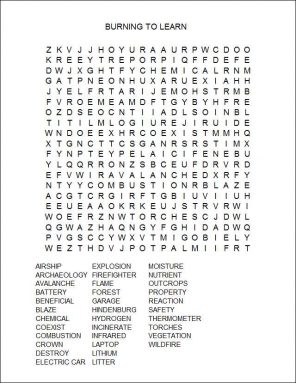Burning to learn
New research on fire, its causes and its behavior is helping scientists lessen the risks that burning poses
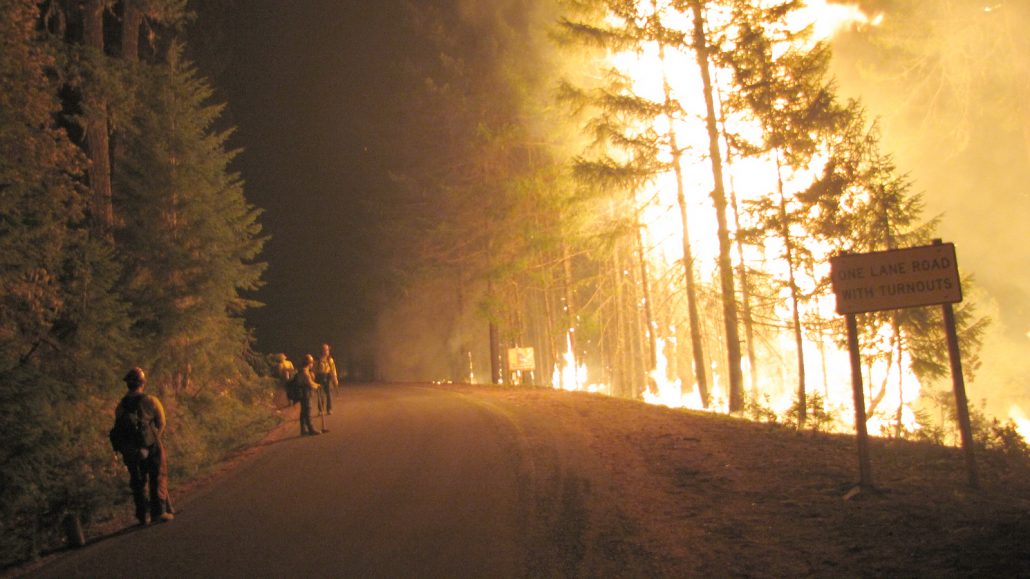
Firefighters control fires that threaten people. But allowing some blazes to burn on will help some ecosystems.
Bureau of Land Management
In central California’s Yosemite National Park, it doesn’t take much to set the forest on fire. A discarded cigarette. A match. Or, as is often the case, a bolt of lightning. On July 31, 2011, thunder boomed as a severe storm pelted the park. The lightning struck trees, igniting several fires. Firefighters with the National Park Service quickly extinguished three fires. But they let a fourth burn on.
They thought it might actually do more good than harm.
That fire began burning through a rugged section of the mixed conifer woods next to the Badger Pass Ski Area. It scorched the bark on big trees. Smaller trees died. A thick layer of fallen, dead and dry plant debris, called litter, further fueled the flames. Within 12 days, this Avalanche Fire — named for nearby Avalanche Creek — had spread through a sprawling swath of forest larger than 1,000 football fields.
Letting the Avalanche Fire burn was no accident, explains Jun Kinoshita. He’s an archaeologist and a firefighter with the National Park Service (NPS). He says that over time, dead vegetation — including leaves, branches and needles — had piled up on the forest floor. That litter serves as extra fuel and can keep a fire burning.
The Avalanche Fire consumed much of the litter that had accumulated since the forest had last burned. That reduced the risk that the next fire would be even larger or more severe. The burned area left behind by the fire also created a barrier, called a fuel break. That break should prevent future fires from spreading to the nearby ski resort. When the next blaze comes, scars from the Avalanche Fire will “act as a barrier to the new, spreading fire.”
“Instead of fighting the fire directly, we looked at it very carefully,” Kinoshita explains. “Overall, we saw a large benefit to that ecosystem by allowing it to burn.”
Fires can be destructive. Many threaten property and lives. But new research on fire, its causes and its behavior is helping scientists lessen the risks that burning poses.
Each year in the United States, fewer and fewer people die in house fires, for example. The scientists who study fire may be experts in chemistry, physics, engineering, archaeology or another field. But all are in the business of safety: Knowing how and why things burn can help people find ways to prevent, extinguish or escape a blaze.
Increasingly, these experts also seek to identify fires that would be better to let burn. Several decades of research shows why not all fires are bad, Kinoshita says — especially for forests. Fires can create openings in dense, thick stands of trees. By letting more light filter in and reducing competition for water and nutrients, new plants will find an environment that spurs their growth. So depending on the conditions, firefighters may choose to just let some trees burn.
They burn anything and everything
Being smart about fire can mean the different between life and death. The National Fire Protection Agency estimates that in 2012, U.S. fires killed 2,855 people and injured more than 16,000. The yearly toll of fire deaths has dropped by more than half during the last 35 years. While that is good news, too many people still die needlessly from blazes. And the problem: Almost anything will burn, notes Matthew Blais. He directs fire technology research at the Southwest Research Institute in San Antonio, Texas. Every year, scientists there burn, leave to smolder, melt, blow up or otherwise incinerate thousands of objects, big and small. Their goal: fire safety.
Left unmonitored and uncontrolled, fires can destroy lives and property. A blaze spews pollution. A big enough fire can even affect weather and climate.
To understand all of these things, Blais and his team study how things burn. They work in a sprawling complex of 10 buildings that house devices capable of testing even big blazes. Indeed, it’s one of the largest fire research facilities in the world.
Its researchers probe general aspects of fire. This includes the speed and temperatures at which different materials burn. Southwest Research Institute scientists also investigate chemicals released in a fire’s smoke. They rely on a host of high-tech instruments, from infrared cameras and thermometers to spectrometers (which identify those chemicals in smoke).
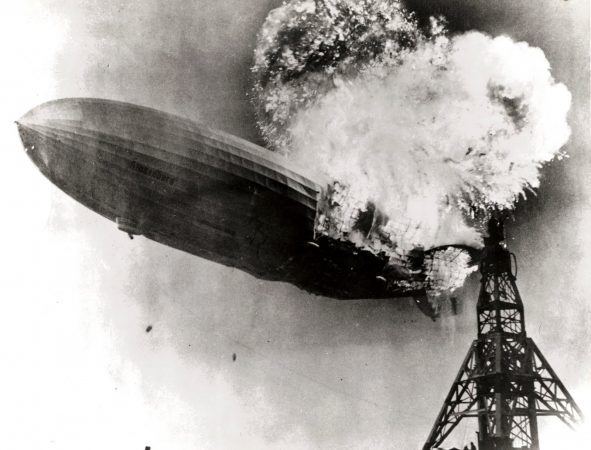
Southwest Research Institute scientists built — and destroyed — three replicas of the Hindenburg. Some conspiracy theorists have suggested the airship had been bombed. But tests by Blais’ team now find it more likely that an electric spark near the rear of the ship caused the fire.
“Our society is constantly inventing new materials, and we need to know how these materials behave in fire environments,” notes Blais. For example, many new devices — from electric cars to laptops — run on batteries. Many are lithium-ion batteries, which pack immense amounts of power into a small volume. In the past 10 years, laptop-computer manufacturers have recalled thousands of these batteries. Why? The batteries sometimes burst into flames.
When these batteries burn, they burn hot — up to 540 degrees Celsius (1,000 degrees Fahrenheit). In November 2013, the electric car company Tesla came under investigation after the battery packs in three of its cars caught fire in the span of just six weeks. Earlier the same year, the Boeing Co. had to redesign, repackage and retest the lithium-ion batteries used on its new 787 Dreamliner passenger jet. The reason: concerns about the batteries overheating and causing fires.
“Battery safety has become very popular lately,” Blais notes. Batteries store energy. When they catch fire, a chemical reaction releases that energy — and sometimes toxic gases too. So engineers seek to better understand how things burn and what ends up in that smoke.
Their goal, Blais observes, is the design of products that will pose fewer risks if they ever do burn.
Avoiding a ‘Hindenburg’ accident in the garage
Among fuels creating some concerns: hydrogen. Car companies have been studying the flammable gas for use in fuel cells. Fuel cells produce electricity that can power electric vehicles. Before hydrogen enters wider use in cars, trucks and buses, scientists want to know more about the fuel’s explosive risks.
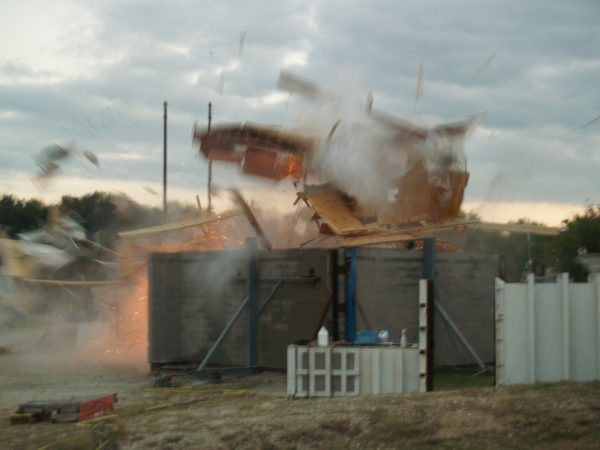
First, the experts built a full-size, two-car garage. To simulate a leak, Blais and his team released a measured amount of hydrogen to mix with the air inside that garage. Then they ignited the gas mixture and filmed the results. The scientists repeated the experiment with differing concentrations of hydrogen. They also repeated the experiment with and without cars parked inside. “We actually blew up the garage 18 times,” Blais says.
Depending on the amount of hydrogen in the air, a flame spread through the garage from the ignition point at anywhere from 0.6 meters (2 feet) to 3.5 meters (11.4 feet) per second. Video of one test showed the front wall, garage door, and roof shattering and flying off the building’s foundation. The Southwest Research Institute group reported its findings in a November 2012 issue of the International Journal of Hydrogen Energy. Although hydrogen leaks that could lead to such fires are unlikely, they certainly are possible, the team concluded. Their data reinforce that car companies, government agencies and consumers should pay extra-close attention to safety if hydrogen-fueled automobiles ever become common.
The institute’s scientists undertake thousands of experiments every year, from testing different ways to store fireworks to identifying fire-retardant construction materials. They even examine the particles in smoke for toxic molecules and other pollutants that can be hard to measure. Their goal: to understand fire at all levels, from the interactions of atoms to the potential for horrific damage.
“We’re constantly designing better technologies and systems to suppress fire,” says Blais, “and to make materials more fire-safe.”
Living with fire
Fire is a part of nature, says Kinoshita, of the NPS. And, he adds, that’s not always bad. In the last few decades, researchers have come to realize that fires can sometimes benefit natural areas.
Forests have “adapted to fire,” Kinoshita says. “And where we can, we’re trying to allow the fire to play its natural role in the ecosystem.”
Part of his job as a fire archaeologist is identifying which fires hold the potential to be helpful. Both fires and firefighting can destroy archaeological sites, he notes. Similarly, some fires can harm the habitat of endangered species while other blazes offer benefits to that habitat. So when a natural fire breaks out, Kinoshita helps assess whether it threatens the environment with more harm than good. (NPS firefighters always have to fight a human-caused fire.) If a natural fire poses a real threat, he says, then firefighters move to put it out quickly.
Of course, when something undergoes combustion — or burns — there’s no un-burning it. And even though people have lived with fire for much of our history, scientists still have many questions about how and why things burn. Finding answers will help people coexist more safely with fire.
Sara McAllister studies the physics of burning at the Missoula Fire Sciences Laboratory. (Physics involves the study of matter and energy.) The U.S. Forest Service operates this special lab, based in Missoula, Mont., to learn more about wildfires. Fires never cease to surprise McAllister. “The more we look into how fires spread, the more we realize how little we know,” she says. And that’s especially true for wildfires, which “make really bad study subjects. You can’t really predict when and where they’re going to start.”
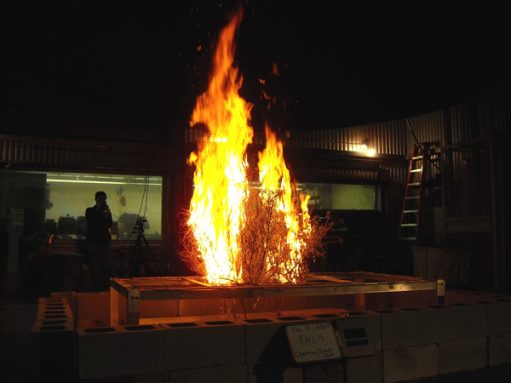
Solving big, unanswered questions drives her lab’s research. For instance, its scientists want to connect the behavior of a sprawling blaze to what happens at the scale of chemically interacting atoms.
One of those key unanswered questions: Why do the crowns, or tops, of living trees burn? Dead trees burn easily enough because they’re dry. Living trees contain moisture. A fire must evaporate and drive off that moisture before plants will burn. Yet moisture-laden living trees burn “just fine” and often provide most of the fuel for a wildfire, McAllister observes.
“We don’t understand why live fuels burn,” she notes. “It could be the chemical difference between live fuels and dead.” In other words, something about the way atoms are assembled within live trees might make them better able to burn, despite any moisture.
Fire scientists want to better understand how fires spread, including why a fire’s climbing uphill will change its speed. They also want to know how a fire reacts to winds blowing in one direction or another — or to shifting wind directions.
The spread of the mountain pine beetle across the Rocky Mountains and Western United States worries these scientists too. The beetles kill millions of trees each year. Scientists suspect this will make it easier for affected forests to burn. But they don’t know that for sure. One 2012 study published in the journal PLOS ONE points out the complications. Its authors reported that when an extreme fire hits a forest suffering beetle damage, the blaze might not behave much differently than it would in a stand of healthy green trees.
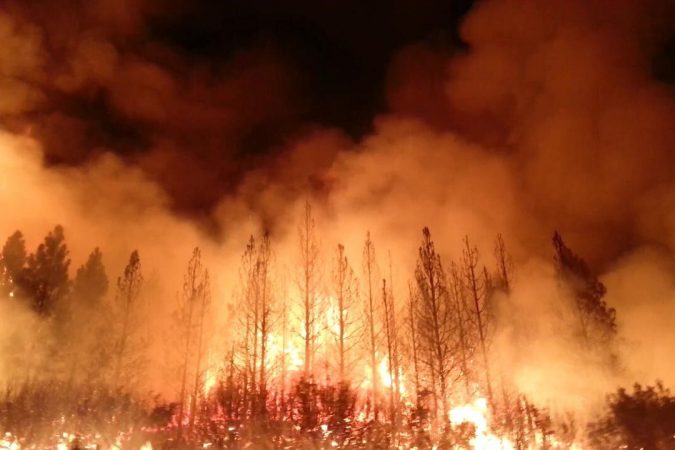
What many people may not appreciate is how many different types of scientists it takes to understand fires. “I work with foresters, ecologists, chemists, electrical engineers and people from other fields,” McAllister says. “A lot of people have to come together to make the research work. You could come at it from any point of view.” Together, they focus on finding ways to manage the destructive fires that threaten people.
Researchers like Kinoshita knew the Avalanche Fire could do more good than harm. But in August 2013, a very different fire broke out near Yosemite National Park. Called the Rim Fire, it quickly spread into the park.
Natural barriers like rivers and rock outcrops affected the fire’s course; so did elevation and different types of vegetation, which acted as fuel. In some park areas, the fire burned a mosaic pattern. That means it left some areas untouched while scorching others. In all, it destroyed more than 1,000 square kilometers (or about 390 square miles) of forest.
Firefighters fought the blaze for months. Worryingly, the fire threatened the woods around Hetch Hetchy Reservoir. Such a fire could pollute this major source of drinking water for San Francisco and other California cities. The fire even invaded residential areas, destroying hundreds of buildings, including 11 homes. California’s Department of Forestry and Fire Protection estimated the cost of controlling this long-running blaze at about $127 million.
But raging giants like the Rim Fire are the exception, not the rule, says the National Park Service’s Kinoshita. “We tend to think of wildfire as the 100-foot walls of flame you see on CNN,” he notes. “But the vast majority of fires we see have one- or two-foot flames.”
Knowing the difference between dangerous and beneficial blazes — and better understanding the science behind them — is critical to safely coexisting with fire.
